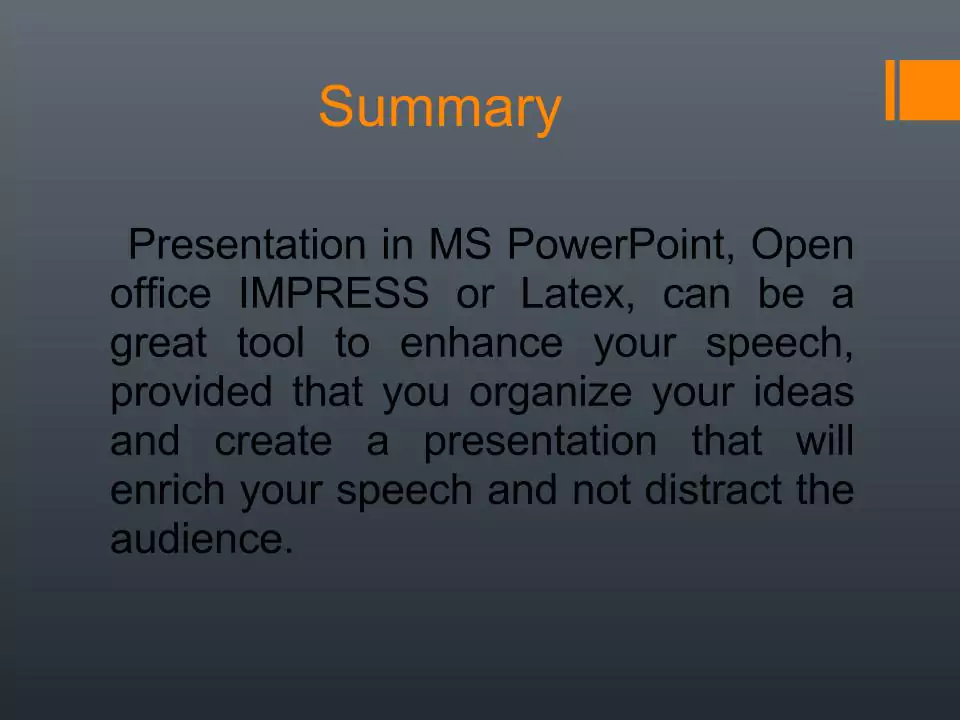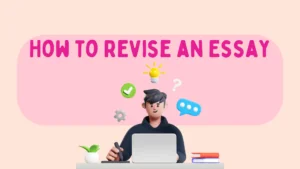 Presentations are given at various occasions, both at work and at school, and at informal or semi-formal events. Nowadays, almost every speech is accompanied by some sort of a presentation. The most common presentation-building tool is MS PowerPoint, which allows the creation of separate slides, joined by one common theme; inserts images and movie clips into your presentation; and even incorporates sound effects into your speech.
Presentations are given at various occasions, both at work and at school, and at informal or semi-formal events. Nowadays, almost every speech is accompanied by some sort of a presentation. The most common presentation-building tool is MS PowerPoint, which allows the creation of separate slides, joined by one common theme; inserts images and movie clips into your presentation; and even incorporates sound effects into your speech.

✅ AI Essay Writer ✅ AI Detector ✅ Plagchecker ✅ Paraphraser
✅ Summarizer ✅ Citation Generator
If you have never used MS PowerPoint, Open Office IMPRESS, Latex, or any other program, you might want to first get acquainted with the tool itself, and then follow our guide to make a perfect presentation using this tool.
Steps in Creating a Presentation
- Learn about your target audience. When it comes to making speeches and presentations, addressing your audience in a proper tone and manner is crucial. Think of what this audience’s peculiar characteristics and preferences could be and try to consider them when making your presentation.
- Brainstorm for ideas. You might have a lot to say on the subject, but when it comes to speeches and presentations (do not confuse them with lectures and speaking sessions), it’s all about being concise and precise.
- Highlight the most important ideas of your speech and put them into slides. Your presentation is not about splitting your speech into parts and placing them on slides. It’s about selecting those “meat-and-potatoes” thoughts and putting emphasis on them by having them in your presentation.
- Make an outline of your presentation and organize all slides in accordance with it. Make sure you are logical, consistent, and coherent in presenting your ideas.
- Think of a few ways to use some images, video clips, or any other ways to illustrate your words. But make sure to keep it relevant to the topic, not just distract your audience with some random, funny, or pretty pictures.
- Proofread your presentation and run it a few times to make sure everything works right; that the text is not displaced; the effects are engaged at the right moments; the images are appearing correctly, etc.
- Practice giving your speech while running the presentation. All the elements have to be synchronized with your words, neither outrunning nor falling behind your presentation.
Topic Selection
Unlike business presentations, where topics are often pre-determined by a current company or an entrepreneur’s needs, the first important aspect of topic selection is getting acquainted with your audience. Since presentations are aimed at showing or explaining an issue to other people, while choosing the topic, you should orient the presentation more on the needs of your audience rather than personal taste.
This rule, however, doesn’t work in the case of being given an academic assignment to create a presentation. Then you can pick any topic you want, though there is also one key point to consider: it is better to choose a topic you are majoring in, or one you are passionate about. Otherwise, your presentation may be boring, or unconvincing, or superficial.
Key Points to Consider
- When you are planning a presentation or a speech, start by knowing the purpose you want to achieve with your presentation. Without a clear goal in mind, you risk throwing around ideas and not reaching your target audience with your presentation.
- At the stage of outlining your presentation and putting slides in order, keep in mind that the ideas that get the most attention from the audience are at the beginning and ending of your presentation. Organize your slides starting with the basic idea that outlines your whole speech, then progress into details and give examples, finishing with a clear and logical conclusion.
- If you intend to have text on the slide, remember these rules: use only one idea per slide, presenting it in a font size not smaller than 32 Arial or 36 Times New Roman, and don’t completely fill the slide with text.
- Whenever presenting any idea on a slide, always ask yourself why exactly you are putting it up there. Is it to make a point, emphasize what you are saying while the presentation is running, or to distract the audience from your words? If the answer is the latter, remove the slide or skip the information you were going to put on it.
- Learn to play with the audience’s emotions and balance your presentation with a little humor, or fun factor, in the middle and at the end of your presentation. The one-slide break in the middle will help your audience to refresh their senses and will reengage those whom you lost along the way with the factual data. A relevant joke, or a funny illustration of your words at the end, will leave a positive tone and an easy-going atmosphere after your presentation.
- It is a smart idea to practice giving your presentation in front of a friend or colleague.
Dos and Don’ts
Dos
|
Don’ts
|
Common Mistakes
- Repeating the same information word-for-word on slides you are going to say in your speech. Slides are for supporting your words with illustrations, numbers and facts, or for emphasizing the most important part of each section of your speech, not for displaying your words for everyone to read.
- Another popular mistake is making your presentation so interesting that it completely distracts your audience from what you are saying.
- With all the effects that popular presentation-building tools offer, it is tempting to trap yourself into some strict frames and then getting stressed during the speech about not exactly fitting into these frames. It is not advisable to link transitions and slide-change to certain time limits. Even if you have rehearsed your speech many times, something might go wrong.
- Trying to cram too much information into the limited time allocated for your presentation. You have to make your presentation at least a minute or two shorter than the actual time-limit you are granted. You need to be able to speak at a natural pace, feel comfortable about time, and reserve some time at the end in case your audience might have any questions.
Now that you have acquainted yourself with the basic presentation making tips and rules, you can check out our presentation samples to link theory with practice.
Follow us on Reddit for more insights and updates.
Samples for How to Create a Presentation
PPT Presentation Essay Sample, Example


 ...
... 




Comments (0)
Welcome to A*Help comments!
We’re all about debate and discussion at A*Help.
We value the diverse opinions of users, so you may find points of view that you don’t agree with. And that’s cool. However, there are certain things we’re not OK with: attempts to manipulate our data in any way, for example, or the posting of discriminative, offensive, hateful, or disparaging material.